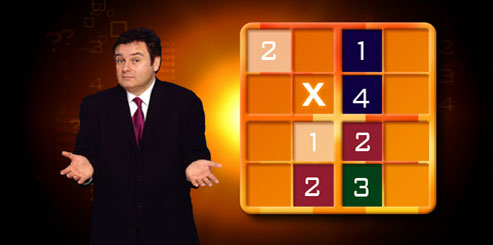Sudo-Q
(→Broadcast) |
(Category added) |
||
| Line 70: | Line 70: | ||
[[Category:Sudoku]] | [[Category:Sudoku]] | ||
[[Category:Current]] | [[Category:Current]] | ||
| + | [[Category:BBC North West Productions]] | ||
Revision as of 11:47, 18 July 2007
Contents |
Host
Broadcast
BBC Manchester for BBC 1, 5 to 16 December 2005
BBC 2, 7 August 2006 to present
Synopsis
Daytime game show combining sudoku and general knowledge. Originally, three teams of three played, but in the second (and subsequent) series this was changed to three pairs.
Round one uses a 4x4 sudoku grid. An empty cell is highlighted and the team that gives the correct number fastest gets a general knowledge question. Getting it right gives them the opportunity to solve another cell for a bonus point. (In the first series, the successful team would get two questions, and thus a possible two bonus squares.)
Round two is the elimination round. Once again the fastest pair to correctly fill a given cell is given a question, but this time if they get it right then they pick one player from each of the other two pairs to play off against each other at filling a cell. The slower player is eliminated and leaves the studio.
The elimination round has also been streamlined since the first series. Originally, the fastest team to correctly fill in the appropriate cell nominated a member of one of the other teams to be eliminated. If the first team answered a question correctly, that player was "frozen out". If they answered wrongly, the nominated team picked one of the answering team to be frozen out. Either way, the eliminated player left the set. At this stage, they hadn't come up with any smooth way of effecting the the transition, so a graphic sting played to cover the cut, which felt a bit clunky. The "window shutter" effect they use now is rather neater.
Anyway, the first team to have all their members frozen out is eliminated from the competition and there's a brief cutaway to a post-match interview, just like every other game show these days.
The third round is played on a 6x6 grid and is a straight puzzle round. Each of the remaining teams nominates one of their number to play. (From the second series onwards, the eliminated players from the second round are not automatically reinstated and there is a bit of business ahead of the third round in which the remaining players are given the opportunity of "buying back" their partners in return for a ten-second penalty in this round.) The two players have 45 seconds (originally, one minute) each on their own personal clocks and take turns to solve highlighted cells, running down their clocks as they go (not unlike the earlier Holmes vehicle Playing for Time, as it happens). A tie at the end of this round is broken with a fingers-on-numbers round with a fresh grid.
The top scorers go on to the end game, in which the team gets three minutes to answer questions. Each time they get one right, they get to solve another cell. This is played on a 6x6 grid with half of the cells already filled, so it works out at six cells a minute - a suitably challenging, but eminently achievable target. There's £50 available for each cell correctly filled, with bonuses for completing rows, columns and regions bringing the jackpot to £2000 (originally £1500). The time for the final is split in half, with one player taking the first ninety seconds, and their teammate taking over for the second ninety (unless one of the team was eliminated in round 2 and not bought back, in which case the remaining player takes the full three minutes). In the first series, when teams of three played, players got a minute each (of course).
In the first series, the best teams returned for a grand final at the end of the series. In the second onwards, they come back the next day to play again for up to five days in a row.
On paper, this show sounded like a recipe for disaster. When TV people sieze upon the latest trend, whatever it is, one expects the result to be an embarrassment, like the Joy Of Text theme night, or indeed the awful Sudoku Live. Fortunately this particular format has largely avoided the pitfalls. The quiz and puzzle elements are well-integrated, and the difficulty is just about right for a lunchtime (stroke teatime) show like this. Lousy title, admittedly, but you can't have everything.
Inventor
Format by "BBC FED Team".
Catchphrases
Eamonn's sign-off: "Be there and be square!"
Not quite a catchphrase, but a running joke is that Eamonn claims eliminated contestants in the next room are appearing on the studio screen "live by satellite".
Theme music
Kev Curtis
Merchandise
Sudo-Q tie-in book (paperback)


